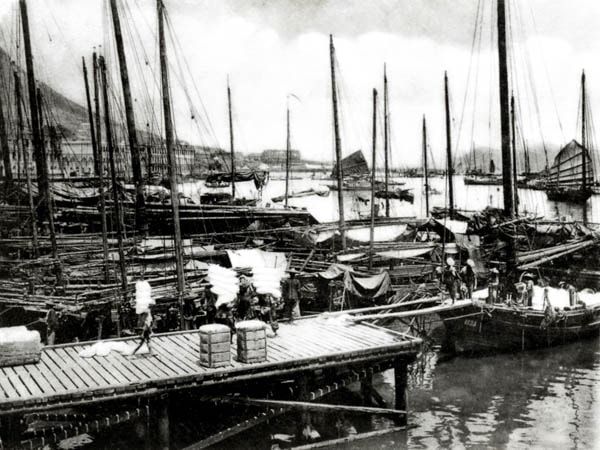From 1860 to the turn of the century, there was tremendous growth in the shipping industry in Hong Kong. In 1861, 2,545 ships totalling 1,310,385 tons entered the harbour. The numbers rose to 4,791 ships of 2,640,347 tons in 1870, and 5,775 ships totalling 5,078,868 tons in 1880. In 1890, the figures rose further to 8,219 ships of 9,771,743 tons, and by 1898, they had risen to 11,058 ships of 13,252,733 tons.[17] The growth was stable apart from occasional intervals of depression. According to the Imperial Maritime Customs returns, Hong Kong in 1882 handled 31.02% in value of all Chinese trade. By 1899, Hong Kong accounted for 40.45% of China’s trade.[18] The main imports to China through Hong Kong then were opium, woollen goods, coal, matches, raw cotton, and kerosene oil.[19]
The rapid growth in shipping during this period was due to a number of factors. First of all, with the number of Chinese residents rising from 92,441 in 1860 to 239,210 in 1898, the growth of Hong Kong’s population significantly augmented the manpower needed for development. The opening of Suez Canal, which substantially shortened the sailing time from Hong Kong to Europe, encouraged trade. There was substantial development in Nam Pak Hong trade in this period, and trade with European nations such as France, Germany and the Netherlands increased. Formerly, trade was conducted mainly between Britain, India and Hong Kong. The opening of more treaty ports after the Second Opium War also gave great impetus to trade. In addition, piracy subsided after repeated joint efforts by the Hong Kong and Guangdong authorities.
Furthermore, more ocean-going and coastal shipping lines started calling at Hong Kong[20]. These included Pacific Mail Line from 1866, Glen Line from 1869, and Messageries Maritimes from 1862 whilst Butterfield and Swire founded the China Navigation Company in 1872. The development of industries like sugar refineries, ship and boat building yards, docks, rope works, and other minor industries boosted shipping. The opening of Siam, Japan and Korea, as well as the opening of new trade routes in the Pacific Ocean, also contributed to the growth in trade and shipping. As William Keswick of Matheson & Co. remarked in 1890, “being a free port and affording every convenience for quick despatch, it [Hong Kong] has become the great centre for shipping, the terminus of many mail lines, and the junction from which new departures are taken. … For foreign trade, it has become the port of Canton, and for the great and growing coast and native trade with North and South, and with Tonquin, Saigon, Siam, and the Strait Settlements and India, it is the emporium.”[21] With the continuous growth in shipping and entrepot trade, related trades like shipping agents, bullion brokers, godowns, shipyards, docks, insurance companies and banks also flourished.



